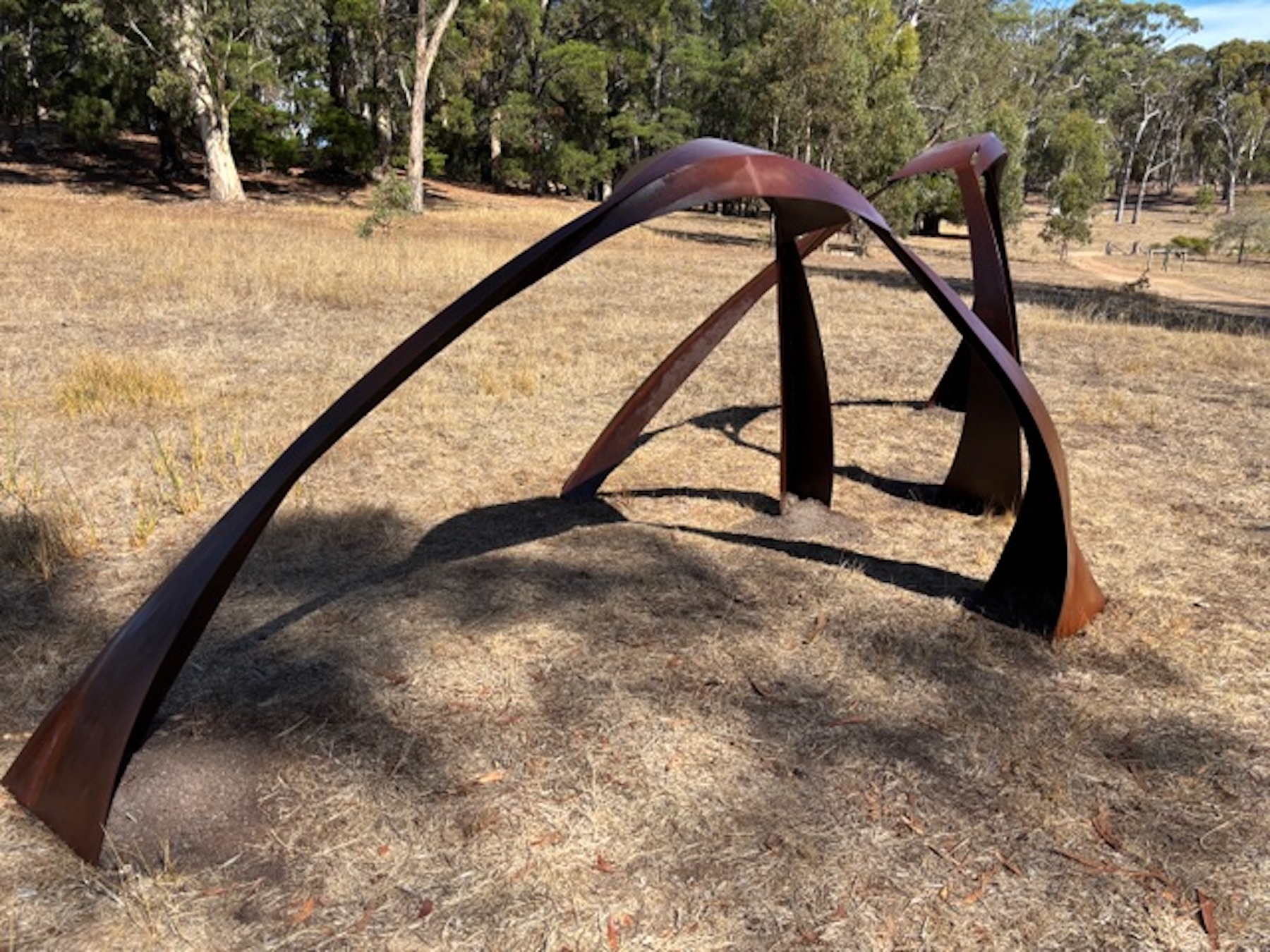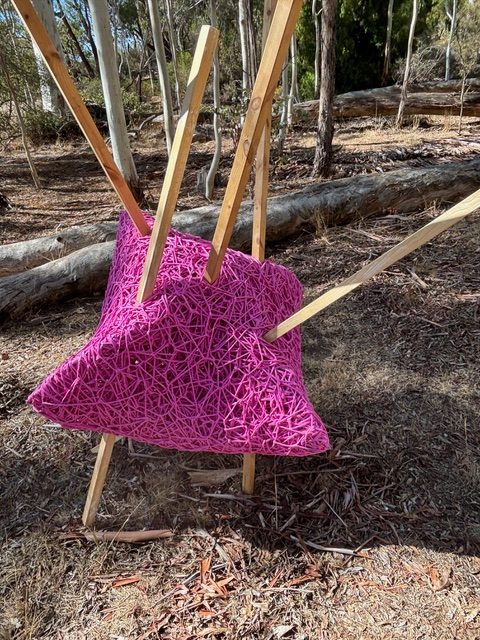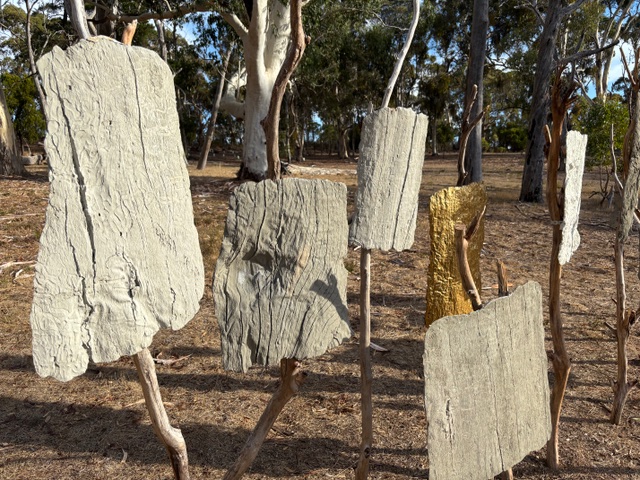Conversations with nature at the Heysen Sculpture Biennial
For its 25th anniversary year, The Cedars hosts an eclectic crop of works that break open the dialogue between nature and humanity — with themes of uncertainty, dread and hope along the way.

Sculpture has been described as ‘mud pies which endure’. There’s a truth in this. Something about the creating of objects, as opposed to paintings and the like, appeals so much that some people grow up to be sculptors.
But what to make? Sculpture broke free in the early 20th century to become whatever it wanted to be, be it a bicycle wheel on a pedestal, a Brillo Box or a glass of water claiming to be an oak tree. The rules kept changing. The idea of sculpture as an object-based art practice within an expanded field was challenged by contemporary ‘post-medium’ art practice which has seen artists using installation-based strategies which defy categorisation as ‘sculpture’ or even as objects.
But as the global humming field of sculptural endeavour resonates around us, it is still possible to believe in something called the sculptural tradition.
The Heysen Sculpture Biennial is a case in point. The project was launched in 2000. This may seem a relatively short time ago but in terms of contemporary Australian sculpture much has happened. Contemporary biennales and biennials have acclimatised the public to a diversity of sculptural expression. This has been facilitated by numerous public art projects designed to be accessible to wider audiences such the Sculpture by the Sea.

In this context the Heysen Sculpture Biennial project, occupies a distinctive position. And, drum roll, this year it celebrates its 25th anniversary, with appropriately, 25 artists and their works. It’s an impressive achievement for the brainchild of artist and environmentalist Helen Lyons, who envisaged an exhibition of installation-based art works in the location of the Shady Pool at the original home of Hans and Sallie Heysen, The Cedars, in Hahndorf, the Adelaide Hills.
You might like
2025 has been envisaged as a return to core principles; participating artists were asked to submit proposals which resonated with the idea of the biennial as an “ongoing creative conversation on the preservation and sustainability of the natural environment”.
The Cedars is a ‘received space’, a point of contact between past and present, where the imprint of Heysen’s world view of nature as the source of truth remains fresh. As such it represents an invitation to re-interpret this place, through art, as a contested zone where not only the idea that humanity and its art exist within nature can be explored, but the capacity of outdoors-sited sculpture to contribute to this dialogue can be tested.
There are several works in this 25th anniversary year which have taken up this challenge. As a general comment they tend to rankle and refuse to ‘fit in’; I found myself spending a long time with these works, weighing up what they what they had to say.
Jane Skeer’s Amorphous Beings is an example. In a stand of drop-dead beautiful saplings, a number of large woven objects sit or are suspended. The artist describes the journey to take her initial concept — based on finding seagrass forms on a beach — to sculptural fruition, as one of “struggle and surprise.” These brightly coloured objects refuse to nestle in. Some have wooden stakes driven through their forms like demons or vampires pinned to the ground. ‘Playful’ yes but also disturbing. Skeer talks about transience and the debris of contemporary life. There is an ominous ‘et in arcadia’ note to this edgy installation which deepened as the late afternoon night faded.

Nearby Liz Butler’s Elements bristles with anger about ‘throw away’ consumerism. There’s no nestling in with this raw installation composed of rusted steel drums, smashed glass and plastic scraps. Butler can turn a rusted water tank into a silk purse because she has a great eye for the aesthetics of the quotidian. But discarded plastic has tipped her over the edge where there is little room for niceties. The Cedars and within it, its environmentally hallowed art, has for the time one spends with this work, been breached. The enemy is through the gates and camped inside. It couldn’t happen here — you think. But this brutal work reminds that the fight is on and nowhere is safe.
Subscribe for updates
Westley Tully rarely fails to find a fresh angle in assemblages of post-industrial debris which carry their own narratives. Once Upon a Time presents as a weathered jetty pylon bound with rusted hasps and tethered by a ball and chain. There is nothing comforting about this motif, particularly when viewed against a stand of magnificent gums. It hints at the horrors of colonial penal punishment and the whipping post or tree. By such means the artist references the tortuous journey of Australia’s trees as they struggle for survival in an indifferent world. When looking at this work, reflect on Hans Heysen’s ironically titled Lord of the Bush (1908) with its image of a massive gum being hauled away by a bullock team.
John Hayward’s Dendonecropolis muses on a similar set of ideas, using casts from dead trees on the Cedars property. Perched on branches thrust into the ground these casts look like the flayed skins of dammed souls paraded in public view or spirits come back to haunt. It’s an arresting motif that deserves further exploration. This note of uncertainty is echoed in Clancy Warner’s dingo (Returning to Country) rising from or subsiding into the dust. For some restorative experience, look for Nicholas Uhlmann’s Resprouter with its (see Lord of the Bush again) promise of new growth.

Tom Borgas would appear to be also going for the jugular with his Heysen Acoustic Mirror. It sits defiantly above Shady Pool like an abandoned road sign. The concave surface of this parabolic form carries a bold black and white chevron design. This surface faces away from the scenic pool towards the surrounding bush, capturing as the artist intends, the random sounds of nature at work. It is a bold, transformative, work which creatively invites viewers to look beyond the object to the context of this special site. The artist’s catalogue notes declare a deep-seating sense of connection with Heysen’s agenda as a sensory-based conversation with nature.
From this perspective I think Borgas is right on the money. His work succeeds in a similar way to Kerr’s Fault-line pathway lined by suppliant twigs and branches by inviting the viewer to step into a reflective zone. The difference is that Kerr’s work contains the ominous suggestion of fracturing and fault lines that run beneath the veneer of ‘caring for the environment’ while bulldozing on a grand scale, for example, koala habitats.
Somewhere within this diverse assembly of works there are some that take the nestling business seriously. Shenshen Zheng’s Cell consists of multiple co-joined ceramic units resembling beehive cells. Mat-like units are draped over a log and lie on the ground. The artist hopes local creatures like insects will recognise a ‘bee Hylton’ when they see one, and check in. It’s a sweet thought which deserves its place on the biennial menu.

Datsun Tran occupies common ground. From Fear Grew Beauty features four outsized spiders looking suitably menacing. There is some reassuring symbolism in their reflections enabling the head count to go to eight, thus avoiding a traditional Chinese association of this number with death.
In an exhibition underscored by uncertainty, dread or wan hope, characteristic works by Greg Johns, Astra Parker and Quentin Gore offer some anchorage. Parker satisfies the soul with a joyful curvature of forms, reaching out, down and upwards in a cycle of renewal. Johns has married his now familiar attenuated figure to a halo-like circle composed of units referencing dried up waterbeds and broken stone. It looks to which be a very deployable motif which could work equally well if sited on on the ground. Gore’s Autumn Flight, a visually arresting mobile of wine barrel staves joined as leaf-like forms is the takeaway from the 2025 Heysen Sculpture Biennial. It’s about Heysen and his love of nature and light. It’s about being in the moment.
The Heysen Sculpture Biennial 2025 continues at The Cedars until June 1
Free to share
This article may be shared online or in print under a Creative Commons licence
